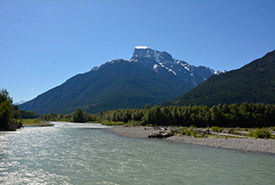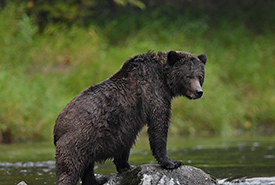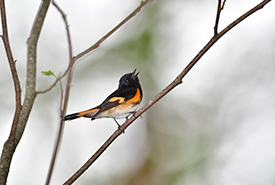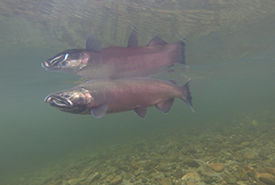Iclhicwani

Freshwater habitats are important to Iclhicwani's waterfowl and migratory fish. (Photo by Harvey Thommasen)
In the Central Coast Rainforest, Pacific salmon, called upon by instinct, journey up the Bella Coola River to make their way into the nutrient-rich environment of its side channels and tributaries to give life to the next generation. As this great migration of salmon journeys upstream, bears, eagles and other wildlife gather along the river to feast on the abundance of spawning salmon. This intricate ecological relationship plays out year after year throughout the Bella Coola valley, including in the Iclhicwani conservation area.
Iclhicwani is the Nature Conservancy of Canada’s (NCC’s) second project in the traditional, unceded territory of the Nuxalk Nation. The conservation area spans 122 hectares of valley-bottom lands that protect rainforest, floodplain and riverside habitat along the Bella Coola River, upstream from NCC’s Saaxwan conservation lands. Conserving Iclhicwani not only improves connectivity among nearby protected lands, including Burnt Bridge Creek Conservancy and Tweedsmuir Provincial Park, but also safeguards the many plants and wildlife that rely on the Bella Coola River and its connectivity to thrive.

Grizzly bear at Iclhicwani (Photo by Harvey Thommasen)
The past and future of Iclhicwani
Harvey and Carol Thommasen, residents of Bella Coola, donated the Iclhicwani lands to NCC via the Government of Canada’s Ecological Gifts Program to realize their dream of protecting the area as a bird sanctuary. Harvey hopes that the protection of Iclhicwani will “also help the salmon and trout, whose populations have also suffered terribly over the past 50 years, and will provide a secure travel corridor for animals like deer, grizzly bear and other large mammals moving through the Bella Coola Valley.”

American redstart at Iclhicwani (Photo by Harvey Thommasen)
The Thommasen’s vision is also supported by the Nuxalk Nation, who are committed to protecting vulnerable ecosystems in their territory. “The Nuxalk Nation has been exercising our rights and title since time immemorial,” says Councillor Iris Siwallace. “We have given our support to the Nature Conservancy of Canada to manage this area as we believe they will be able to protect this land for our Putl’lt— those who are not yet born.”
Thanks to contributions from many generous donors who also share this vision, NCC can now embark on the next steps for Iclhicwani, including the generation of a baseline inventory of the land, as well as the formulation of a management plan to guide long-term stewardship.
Ecological significance
Iclhicwani protects a small but vibrant piece of a coastal temperate rainforest, a globally rare ecosystem that is only found in British Columbia and Alaska, occurring on less than one-fifth of one per cent of the Earth’s surface. Here, one can find habitat for threatened species, such as western toad and northern goshawk.
Surrounding the property are public lands conserved under the Great Bear Rainforest Agreement, which protects the biodiversity of the coastal temperate rainforest. The conservation of Iclhicwani by NCC means that the land will be protected from development pressures.

Coho salmon adult at Bella Coola River (Photo by Harvey Thommasen)
Aside from the famous rainforest, Iclhicwani harbours both biodiversity and ecosystem diversity, including an extensive system of beaver-pond wetlands that provide key habitats to freshwater species from salmon and cutthroat trout to amphibians and streamside plants. The forest located on Iclhicwani is still largely intact with mature western redcedar, cottonwood and red alder.
The Bella Coola River, and especially its intact estuary, is a highly productive ecosystem, attracting both Pacific salmon and their predators. While grizzly bears, black bear (including their famous subspecies, the Kermode, or Spirit, bear) hail from Tweedsmuir National Park and pass through the Burnt Bridge Conservancy to reach the river for their hunt, waterfowl such as the western grebe and the great blue heron are also lured to the river by the abundant fish population. Birds from coastal and interior BC rely on Iclhicwani and neighbouring lands as a transition zone and nesting habitat. These species include the western tanager, black headed grosbeak and American redstart.
Cultural significance
Adjacent to the property is the Burnt Bridge Conservancy, the traditional, unceded Nuxalk village site of Nutl’lhiixw, which harbours an essential portion of the Nuxalk-Carrier Grease trail system. This trail reflects 6,000 years of history as a vital corridor of exchange for Indigenous Nations. To this day, it is maintained by Nuxalk Nation, Ulkatcho Nation, Lhoosk’uz Dene Nation, Nazko Nation, Lhtako Dene Nation and the Lheidli T’enneh.
The Nuxalk Nation has a deep connection with the groves of old-growth red cedar found along the Bella Coola River, many of which bear the marks of cultural use. Protecting Iclhicwani from development will continue to ensure that this culturally and ecologically significant forest can continue to nurture wildlife, and support traditional Nuxalk activities such as hunting, fishing, mushroom gathering and cedar bark collection.
Partners in conservation
The Nature Conservancy of Canada thanks the Nuxalk Nation for their support and for welcoming NCC’s work within their territory.
NCC is grateful for the generous funding support for this project from:
- Harvey and Carol Thommasen
- Carla Reed
- Rodney Briggs and Robin Pascoe
- Linda Griffiths and Gail Moyle
- C. Robin and E. Jennifer Harrison
- Margo Wood and Eric Grace
- Government of Canada through the Ecological Gifts Program




